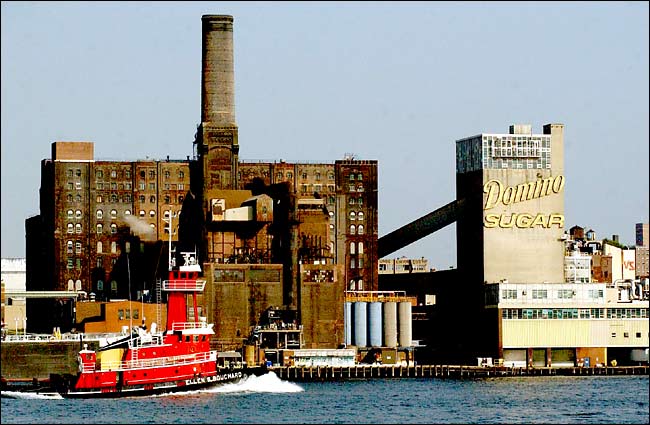
Antibalas, one of the latest Brooklyn grown bands to reach international fame, hit the BAM Opera House stage as the headliner of their Takeover all-night party the first Saturday night of November. There was a line out the door and around the corner down St. Felix St. to get into the multi-faceted all-night party. Five bands, four films, three djs, art video installations throughout the building, and berlesque in between musical acts on the main stage kept the party going into the early hours of the morning.
Antibalas has played all over the world, from Japan to Portugal making stops throughout Asia and Europe along the way. They've performed all over the city as well from Central Park Summer Stage to Rikers Island Prison Facility, but they are and have been a Brooklyn band from the start. Bringing their pulsing afro-beat grooves to the BAM center stage was a new honor all its own.
"That opera house bestows honor on whoever's fortunate enough to play there," said Stuart Bogie, the band's tenor saxophone player and influential band member since 2001. He's seen the band grow extensively both musically and in fame since their founding by Martin Perna in 1998. Many critics have dubbed them as the torch-bearers of afro-beat, the genre pioneered by Fela Anikulapo Kuti and his band Afrika 70, however, none of the band members see themselves as catering to that role
"A lot of the critics have said our music has become more and more our own and less and less imitations of Fela's music. Which I think is totally wrong. I don't think the opposite is true, but I think that's the most invented trash I've ever heard. Antibalas didn't understand Fela's music when they started. They loved it and were inspired by it, but they weren't equipped to imitate it. They didn't have the technique. We have that now to a much greater extent."
Antibalas has released four albums to date. Their latest, Security, came out earlier this year and received widespread critical acclaim. Security represents the progression of Antibalas' sound in different ways. When I spoke with Stuart Bogie, he elaborated further on Antibalas' progression, "We're better at breathing with in the afrobeat style. Technically the dynamic element has grown a lot in our music. The swell, the push, the subtle ways of playing the ostenatos and patterns, so that they still dance with each other. Afrika 70 was very adept in that way."
Like most members of Antibalas, Bogie takes part in a number of musical projects, some with other members of Antibalas. One such project is Sway Machinery, an amalgamation of middle-eastern and African sounds and influences, of which Antibalas trumpeter Jordan McLean is also a member. Bogie has collaborated with an extensive list of musicians including Celebration, TV on the Radio, Medeski, Martin and Wood, Burning Spear, Sinehead O'Conner, The Wu-Tang Clan, Rana, Dub is a Weapon, Congo Ashanti Roy, and Tony Allen just to name a few.
Antibalas is almost entirely composed of Brooklyn residents. Bogie lives in Williamsburg, Amayo, the lead singer/percussion player lives in Greenpoint, and Martin Perna, the baritone saxophone player and band's founder lives in Bushwick. Their keyboard player, Victor Axelrod, lives in Park Slope. Gracing the stage at BAM's opera house adds some hometown love to the extraordinary list of venues all over Europe and the United States including a castle in Portugal, manor houses along the French Riviera, Bonnaroo, and the Filmore at Irving Plaza.
Antibalas shared the stage with Be Your Own Pet, The Exit, Heartless Bastards, and Dirty On Purpose. The ladies from Ubiquita NYC, DJ Reborn, DJ Moni, and DJ Selly, kicked out the jams for a rockin dance party in the upstairs ballroom accompanied by Vikter Duplaix. Films curated by the critically-acclaimed BAMcinématek were showing all night as well including a tongue-in-cheek Lindsay Lohan Mid-Career Retrospective and the violent, edgy cult favorite Pusher Trilogy by Danish filmmaker Nicolas Winding Refn.
As always, Antibalas made sure to impart some inspirational anti-establishment words between songs. Jordan McLean implored the audience to stay in touch with the news as a new Attorney General is appointed. He also posed a question to the audience asking why it was so important for the United States to define its position on torture. Following in the tradition started by Fela Anikulapo Kuti, Antibalas uses its music as a medium for anti-establishment protest.
Antibalas has enjoyed a steady rise in fame and critical acclaim since their formation in 1998. Almost ten years in, it will be interesting to see where the band goes from here. They've already traveled the world spreading and keeping alive the afrobeat tradition representing Brooklyn the whole way. It will be interesting to see if they can keep their momentum strong as they continue to evolve together and grow as musicians.




































